Features and schemes for planting onions in the fall before winter
Onion sets can be planted both in autumn and spring. However, pre-winter sowing has many advantages in any climate and is therefore used frequently. We will tell you what features this method has, what are its advantages and what additionally needs to be taken into account by a gardener planting winter onions.
The content of the article
- Features of planting onions before winter
- Varieties and hybrids of winter onions
- Preparing the soil for autumn planting
- Selection of planting material and preparation
- Scheme of planting onions in the fall before winter and cultivation features
- Features of caring for winter onions
- Harvesting and storage features
- Helpful hints
- Conclusion
Features of planting onions before winter
Regardless of which type of onion is chosen, winter cultivation has features that you need to remember.
Ripening period
Winter onions can be both mid-season and late-season... However, in any case, when planting before winter, it turns out to harvest 3-4 weeks earlier than when sowing spring onions.
Usually in central Russia, winter onions ripen in July. As a result, its harvesting falls on more or less free time from harvesting other crops. In addition, the vacated beds can be used for early ripening crops or sowed with siderates for the new season.
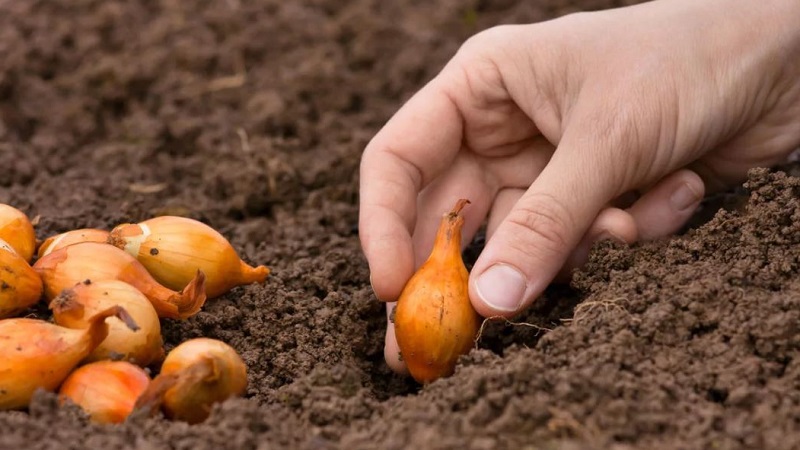
Yield
The yield of winter onions depends on the variety... However, due to the longer growing season, winter varieties usually surpass spring varieties in yield.
When onion is grown on an industrial scale, the yield of winter varieties usually averages 40-45 t / ha. With manual cultivation, this figure will be higher due to the fact that the seed material and ripe bulbs are less damaged by technology.
Important! When growing winter onions, it must be borne in mind that losses of up to 10% of the seed are inevitable during the winter. This also affects yields, so planning should take into account possible waste.
Characteristics of the bulb, description of the appearance, taste
Many varieties of onions have already been bred for winter cultivation. Most of them has a dark yellow color of the husk, but there are also white varieties... The bulbs are generally round and large.
The taste of winter onions also depends on the variety., but most often it is semi-acute. Nevertheless, among the popular varieties there are also those with a pronounced pungent taste, for example, Senshui.
Growing regions and climate requirements
The best regions for growing winter onions are those in which the following climate features are simultaneously observed:
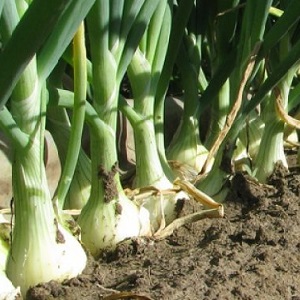 Relatively mild winters with frosts not lower than -30 ° С.
Relatively mild winters with frosts not lower than -30 ° С.- Abundant snow cover. Without snow, onions can hardly withstand frosts stronger than -10 ° С, but with snow it may well survive at temperatures down to -20 ° С and below.
- Early spring with a friendly flood.
- Warm and little rainy summer - onions love moisture, but cannot stand excessive dampness and rot on the vine.
Actually using high-quality zoned seeds, winter onions can be grown throughout Russia, with the exception of the Far North and regions of Siberia with extremely cold winters.
Benefits of planting before winter
The advantages of winter onion cultivation are the following points:
- The gardener does not have a headache about where to store the seeds.The fact is that the sevok is very capricious during storage; germination is often lost over the winter. Autumn planting allows you to solve this problem: the seeds in the soil overwinter in the most natural way for them.
- Winter onions are harvested earlier, and as a result, in the second half of the season, they can be used to grow early maturing crops, such as edible grasses or radishes.
- Onions planted before winter "diverge" in time with some pests. For example, the onion fly, which is pretty annoying for spring plantings, is not particularly scary for winter varieties.
- Small sevok, planted before winter, practically does not shoot.
The main disadvantage of winter planting - the inevitable death of part of the planting material. However, with proper cultivation, losses do not exceed 5-10% - in the spring, more can be lost from cabbage flies or nematodes alone.
Varieties and hybrids of winter onions
To sow before winter, many are suitable varieties and hybrids of onions... In particular, gardeners often use:
 Stuttgarter Riesen (photo on the right). A variety of German selection. Has a yellowish brown skin. The bulbs are distinguished by their large sizes - specimens weighing up to 250 g or more are often found. It has a long shelf life.
Stuttgarter Riesen (photo on the right). A variety of German selection. Has a yellowish brown skin. The bulbs are distinguished by their large sizes - specimens weighing up to 250 g or more are often found. It has a long shelf life.- Centurion... High-yielding non-shooting hybrid. The bulbs are stored for up to 8 months.
- Shakespeare... A winter-hardy onion variety that can withstand a snowless winter with frosts down to -18 ° C. One of the most popular winter varieties for summer cottages and vegetable gardens.
- Danilovsky 301... Mid-season variety with purple scales and pulp. Resistant to frost and pests. Has a sweetish and not too spicy taste. Keeping quality is lower than that of Stuttgarter and Centurion, but not bad either.
- Senshui... An early ripe variety with yellow-brown scales. Resistant to shooters and downy mildew. It has a bright spicy taste.
In any case, it is necessary to choose for winter planting those varieties that have passed zoning in a particular agricultural region.
Important!You should not use varieties intended for spring planting for sowing before winter. They do not tolerate wintering well and shoot strongly, while, due to winter damage, such varieties ripen even later than during spring planting. As a result, all the benefits of winter cultivation are lost. In an extreme case, you can plant a rejected spring set on a feather before winter, but even so you need to remember that most of the seed will die.
Preparing the soil for autumn planting
First of all, you need to choose the right site.
To the plot the following requirements are imposed:
- The absence of predecessors prohibited by the rules of crop rotation. For example, you cannot plant onions over onions or over garlic. The best predecessors are peas, soybeans, beets, cabbage and grains.
- Sufficient light during the day.
- Elevation. Onions do not like excessive moisture, so they cannot be planted in lowlands, where melt water accumulates in the spring.
The ideal place would be the area that is free of snow first in the spring. and warms up in the sun. If this is not the case, you need to make a bulk bed or surround the plot with drainage grooves.
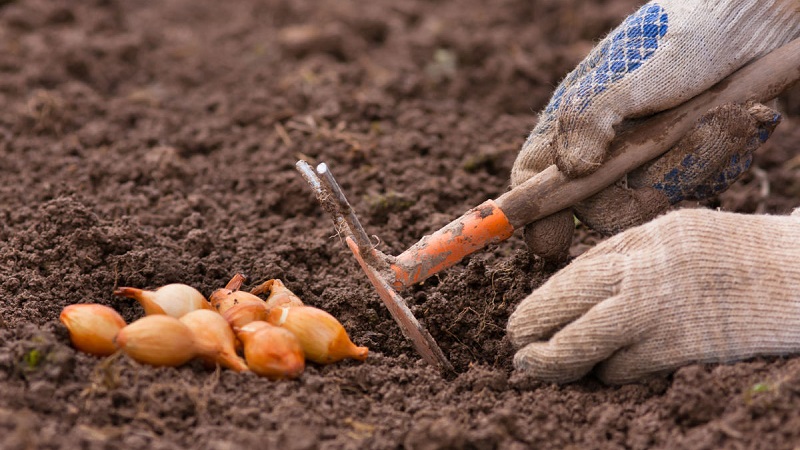
Onions love moderately loose soil, therefore, if there is clay soil on the site, it must be structured. To do this, add coarse clean sand when digging. If, on the contrary, the soil is too sandy, you need to bring in good turf soil.
Onions do not like overly acidic soil.... Therefore, if excessive acidity is found when checking the litmus paper of the soil extract, the site should be liming. For the same reason, you should not use bottom peat as fertilizer for the onion site: it structures the soil well and enriches it, but at the same time it acidifies.
Fertilize before planting winter onions... A good option for any soil includes 1 sq. m beds the following means:
- from 3 to 5 kg of high-quality humus;
- 1 glass of wood ash;
- 1 tsp. nitrogen, potash and phosphorus fertilizers;
- 1 tbsp.l. the combined product Agricola for Garlic and Onion.
And here the introduction of clean manure is undesirable: it will repack only in the spring, when it will be of little use for the seed.
Selection of planting material and preparation
Seed preparation for winter planting, as well as for spring planting, includes includes calibration, soaking and disinfection.
Soak
Whether it is necessary to soak the sevka for autumn planting is a moot point. The point is that here the following factors are essential:
- Soaked onions grow much faster. In addition, at this stage it already becomes clear which seeds are suitable for planting and which are not similar.
- An onion that has developed too much before frost will die. The leaves will not survive the snow anyway. Here you need to proceed from the climate and planting time. Frosts are not particularly terrible for dry onions in the soil, but swollen ones are unstable to them.
In the event that it is nevertheless decided to soak, use the following methods:
- Saline solution - 1 tbsp. l. salt per liter of water. The bulbs are immersed in it for 5 minutes.
- Copper sulfate - 1 tbsp. l. for 1 liter of water. Soaking time is 3-5 minutes.
- Potassium permanganate. The bulbs are placed in a deep pink solution for the same time.
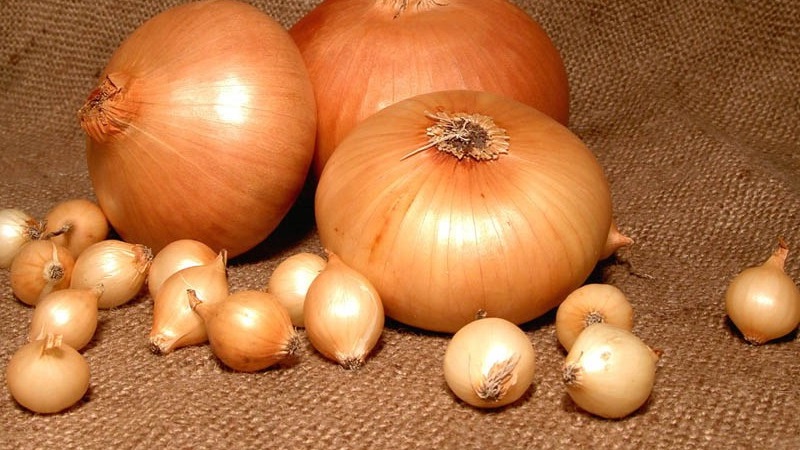
At the end of soaking, the onions are dried on a cloth or paper for a day.... After that, you can start planting.
Important! Combination of soaking is possible. In this case, the onions are placed in a saline solution for 3 minutes, and then, without drying, they are transferred to a container with vitriol or potassium permanganate.
Treatment
It is very useful to treat the seed with special preparations before planting., except for potassium permanganate and vitriol. Here, preference should be given to "Fitosporin". It perfectly disinfects onions and then stimulates development already in the soil. To do this, the drug is diluted in the dosage specified by the manufacturer (it is different for different types of funds), and then the planting material is placed in the finished solution for 10-15 minutes, after which, after drying, it is planted in the soil.
Other
In addition to soaking and processing with preparations, the seed material needs to be calibrated.
The seeds are divided into the following categories:
- Wild oat - bulbs less than 1 cm in size. They are planted only before winter and only on a turnip.
- Sevok. These are bulbs up to 1.5 cm in diameter. They grow well and do not shoot. They are planted on a turnip.
- Samples. Large seeds from 2 cm in size and above. They are planted on greenery or already on seeds, because they will certainly give flower-stalks in the spring.
- Pacifiers. They are soft and sluggish to the touch. They are not sown because they are definitely not similar.
Seeds and hauls should be planted in different beds.
Important! Experts recommend that you additionally calibrate the sowing by size and plant bulbs of about the same size on one bed. This measure increases the yield, and the onion sprouts more amicably.
Scheme of planting onions in the fall before winter and cultivation features
Planting depth and seeding rate differ depending on the type of onion, but there are common points characteristic of winter cultivation.
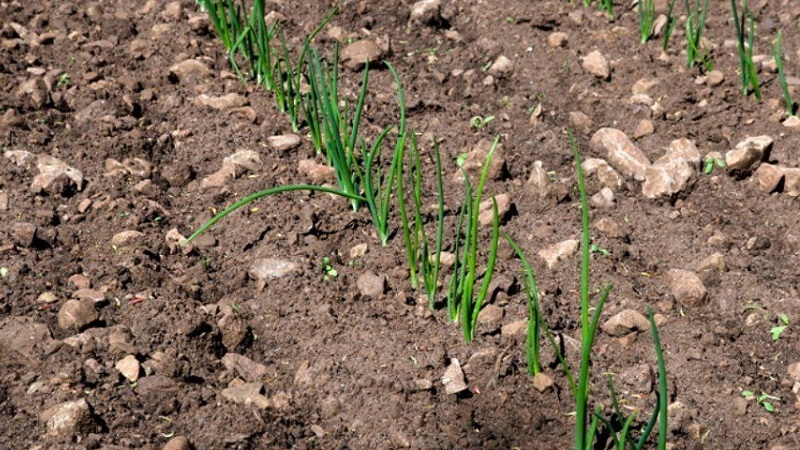
Preparation of arable land and planting material
They begin to prepare the onions for planting in advance.... Calibration and selection of seeds should be carried out, if necessary - soaking.
Before sowing, the site is dug up and harrowed, carefully breaking up the lumps. Wherein fertilizing is immediately applied to the soil for future planting.
Selection of predecessors
Ideal predecessors for onions are crops with a long and deep root system (potatoes, carrot etc.). Tomatoes, cabbage, lettuce, pumpkin, legumes and other melons are also good.
Basically, onions grow well after almost all crops... The only exceptions will be spring onions and garlic - after them, it is impossible to sow winter varieties. Also, there will be no good harvest after sunflower and corn.
Landing dates
Sowing time depends on the climate in a particular area... It must be assumed that the bulbs should be in the ground 10-15 days before the frost begins.If forecasters promise that the temperature during the week will be stable from +5 to + 7 ° С during the day with a gradual decrease, this is a sign that it is time to sow winter onions.
Usually the seeding time is:
- for the central zone of Russia - mid-October;
- for the Urals and Siberia - late September or early October;
- for the south - the end of October.
Planting with seeds
When sowing onions with seeds, it must be borne in mind that this procedure should be carried out only on frozen ground, it is even possible on the first snow, when thaws are not expected. This is due to the fact that the seeds should start growing only in the spring - unlike the bulbs, their seedlings will not overwinter.
Seeds are sown denser before winter than in spring, and are additionally covered from above pre-prepared earth and spruce branches. The use of peat is undesirable: it is hygroscopic, during the first thaws during the day it will be saturated with moisture, and at night it will freeze, forming a continuous ice crust.
Bulb planting
It is necessary to plant bulbs based on the following:
- Sevok is planted at a distance of 7-8 cm from each other. Future bulbs need room to grow.
- The samples are planted thicker - 3-5 cm from each other. It is grown mainly for feathers.
- Large bulbs planted for greenery and seeds can be sown side by side.
After sowing the site is mulched or covered with spruce branches and left until spring... In the spring, the mulch is removed.
Disembarkation scheme, depth and distance depending on the variety
Now consider techniques already characteristic of specific types of onions.
Shallot
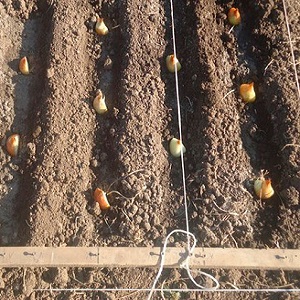 The agricultural technology of growing winter shallots is the same as that of onions.
The agricultural technology of growing winter shallots is the same as that of onions.
His sown at the same time according to the following scheme:
- row spacing - 30 cm;
- the distance between plantings is 15-20 cm (this is due to the fact that the shallots form bushes of about 20-25 small onions);
- embedment depth - at least 3-4 cm.
Onion
Batun, or Tatar, sown before winter after the beginning of the first small frosts... Usually in central Russia this is the end of November. For planting, choose loamy soil.
Sowing is carried out according to the scheme:
- row spacing - 20-22 cm;
- embedment depth - 2 cm;
- the distance between the seeds is about 4 cm.
Decorative
Decorative bow, or allium, usually not used for food... It is grown for aesthetic purposes, although there are edible varieties.
The landing is carried out as follows:
- a hole is made three bulbs deep and two wide;
- the distance between the holes is from 10 (for low-growing varieties) to 25 cm (for high ones);
- the bulbs are sprinkled with earth in the holes and slightly mulched.
Planting time is from September to October.
Onion
Onion before winter planted according to the following scheme:
- planting depth - 3-4 cm, while the neck of the bulb should be 1-2 cm below the soil;
- row spacing - 15-20 cm;
- the distance between the bulbs is 8-10 cm.
It can be useful:
Diseases in onions and how to deal with them
Features of caring for winter onions
Although winter onions are unpretentious, they need some care. What exactly does a vegetable grower need to do?
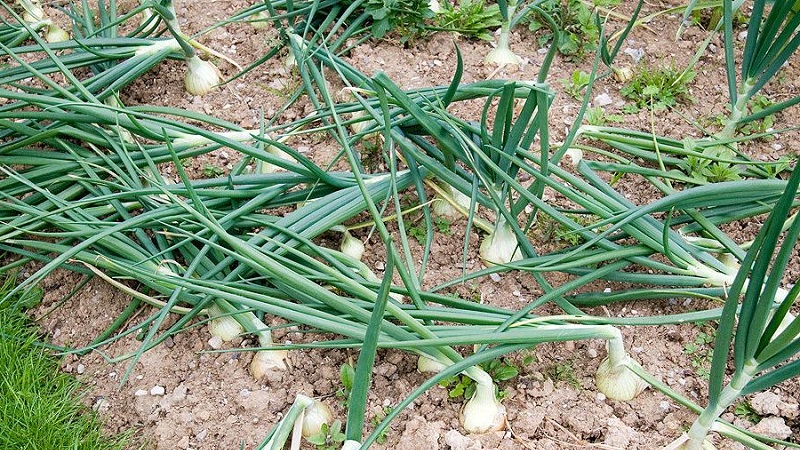
Top dressing
The first feeding of winter onions is carried out after the emergence of shoots... For feeding use:
- ash - 1 glass per 1 sq. m;
- bird droppings solution - 1 kg per 10 liters of water;
- diluted mullein.
You can also use synthetic fertilizers (nitrate, azofosku, superphosphate, etc.) in the dosage specified by the manufacturer. However, it is better to under-feed the plants here than over-feed them.
If the soil is poor, repeat feeding after 2-3 weeks.
Watering mode
Watering onions as the earth dries up and is usually combined with loosening the soil... It is important here at the same time not to let the plantings dry out, and not to overflow. The amount and mode of watering depends on the weather and the degree of humidity of the site.
Loosening and thinning
Loosening is carried out regularly... It is also combined with weeding. When loosening, it is important not to damage the bulbs.
Thinning is required if growing from seed... In this case, if too many plants survived, they are slightly pulled apart in the garden so that at least 2-3 cm remains between the shoots.
Harvesting and storage features
Harvesting winter onions, when the husk acquires density and colorcharacteristic for a particular variety. Lodging of leaves is also a striking sign.
The onions are carefully dug in with a pitchfork, and they are simply pulled out of the loose soil by the leaves. After that, he is allowed to lie down for 1-2 days so that the earth dries up and crumbles, and then the leaves and roots are carefully trimmed with scissors or pruning shears. If you plan to keep the onions tied in braids, trimming the leaves is not necessary. The roots are always removed. It is important not to damage the bulb.
After trimming, the onions are dried for 3-5 days. in the sun or, if the weather is rainy, under a canopy. Then it is stored in a cool dry place.
Helpful hints
When growing winter onions, remember the following:
- Onions planted before winter are stored worse than spring ones. Therefore, the harvest must be used for food faster.
- The composition of fertilizers is selected depending on the purpose of the onion. If it is grown on a feather, special attention is paid to nitrogen fertilizers when feeding; if on a turnip or head - potassium and phosphorus.
Conclusion
The cultivation of winter onions has its own characteristics, however, with proper agricultural technology, its yield is not lower than that of spring onions. It is important to comply with the planting dates, and the seeding scheme should be applied depending on whether the onion is grown on a turnip, feather or head.